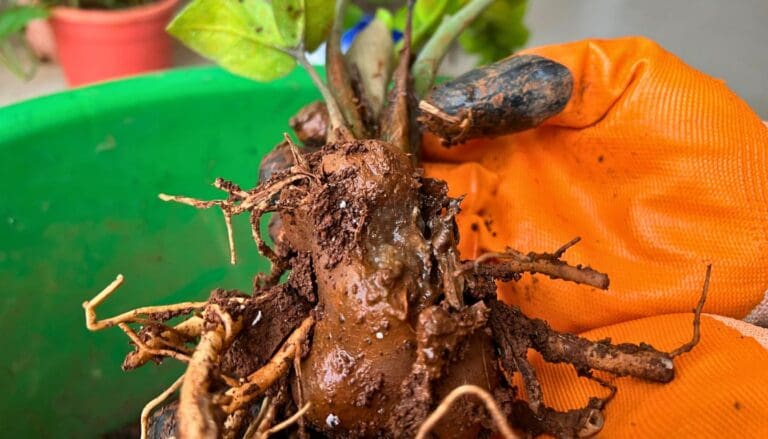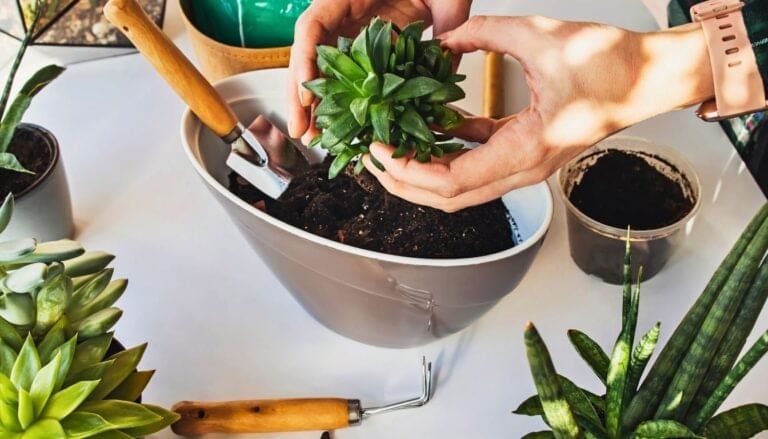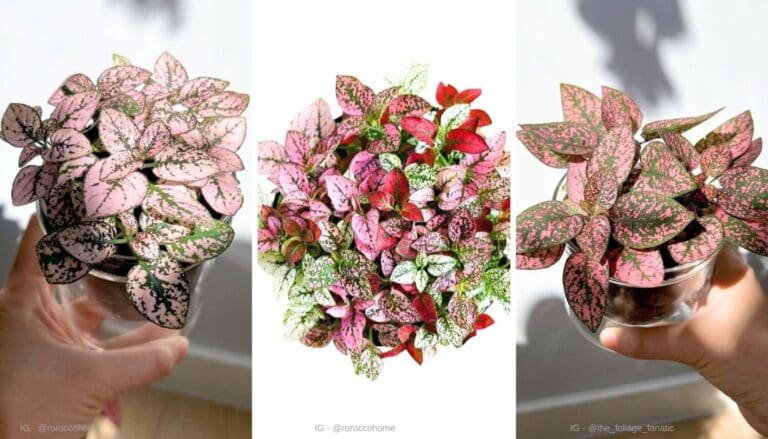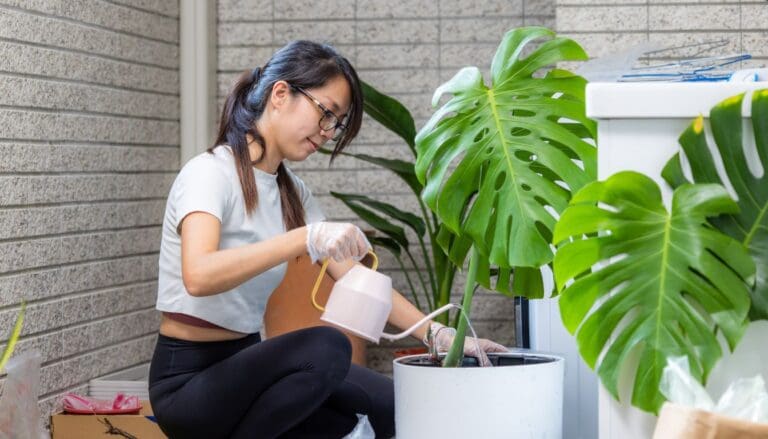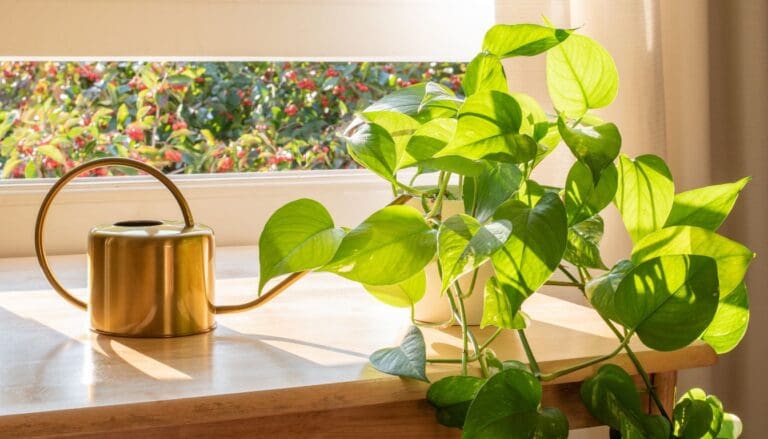Birds Nest Fern Care Guide: Key Tips for Lush, Healthy Fronds!
For all my fellow plant enthusiasts out there, I have to tell you about the Bird’s Nest Fern! It’s one of those plants that looks like it could’ve come straight out of a whimsical fairy tale.
Known for its lush, ripple-edged fronds that spring out like a fountain, it’s an absolute must-have for indoor plant collectors. Have you seen these green beauties yet? 🌿✨
Caring for a Bird’s Nest Fern is a breeze, and it’s super rewarding too! I mean, who wouldn’t love a piece of the tropics in their living space?
They thrive in warm temperatures and enjoy medium to bright, indirect light. Just the thought of their cozy little frond nest makes me smile.
Are you warming up to the idea of having your own little tropical escape? 🏝️
Remember, despite their exotic looks, these ferns are actually pretty chill when it comes to maintenance.
I keep mine by an east-facing window, and it seems to love it there! And, here’s a fun tip: these green pals are fine with some humidity—it’s like giving them a mini spa day, every day!
Who’s ready to turn their home into a Bird’s Nest Fern paradise? Show of hands, or better yet, leave a comment! 🙋♀️🌱
Please note: Simplify Plants is reader-supported. As an Amazon Associate, I earn from qualifying purchases made by our readers with no extra cost added to you all! Some links in the post are affiliate links and I get a commission from purchases made through links in the post.
Understanding Birds Nest Ferns
Who knew a houseplant could give your room those tropical vibes without the sandy mess? Let’s dive right in and get to know our frond friend, the Bird’s Nest Fern!
Species Overview
First up, let’s clear up the basics. The Bird’s Nest Fern, also known by its scientific name Asplenium nidus, is quite the show-stopper with its ripple-edged fronds that seem to unfurl like a mysterious scroll. Here’s a quick rundown:
- Family: Aspleniaceae
- Common Names: Bird’s Nest Fern, Crow’s Nest Fern
- Growth Rate: Moderate – patience is key, my friends! 🐢
- Lifespan: Long-lasting with proper care. Think of it as a potentially perennial buddy!
Have you ever seen the center of the fern’s rosette? It resembles a cozy nest, hence the name. But don’t expect any birds to move in—it’s just a plant party!
Natural Habitat
Picture this: high up in the trees, in a balmy rainforest, that’s where these lush beauties feel at home.
Originating from the tropical regions, Bird’s Nest Ferns are epiphytic – meaning they’re cool with growing on other plants without harming them. Talk about being a peaceful roommate, right?
Here’s where they thrive:
- Light: Dappled sunlight filtered through the treetops. 🌤️
- Humidity: They love moist air! Think sauna-like vibes without the heat.
So, have you ever spotted one of these ferns outside of your local plant shop, maybe on a trip to a tropical paradise? Share your experiences below!
And if you’re thinking of bringing some greenery into your space, why not reach out to these ferns? After all, they do a great job of purifying the air—natural air fresheners, you might say! 🌱✨
Fundamentals of Care

I’m here to share the scoop on Bird’s Nest Fern care. These tropical treasures need just the right touch of TLC, so buckle up; it’s time to turn you into a fern pro! 🌿💪
Lighting Requirements
Let there be light—but not too much! My feathery fern friends totally jive with bright, indirect sunlight. Think of it like wearing sunglasses; they love the light but appreciate some shade.
Got an east or west-facing window? Your fern’s gonna love it there! 🕶️
Watering Techniques
When it comes to hydration, these ferns say “Keep it balanced.” You’re aiming for moist soil, but never soggy—kind of like a perfect sponge cake. 🍰
Check in with your green buddy by giving the soil a quick poke. Dry? Time to water. Wet? Give it a rest.
Soil Composition
The dirt on dirt? Bird’s Nest Ferns dig peat-based potting mix with splendid drainage. It’s like their favorite pair of comfy socks—supports without suffocating.
Mix in a little perlite, and they’ll be thanking you with the lushest of fronds!
Temperature and Humidity
Ferns are basically like me on vacation; they adore it warm and a tad steamy. Keep the thermometer reading a cozy 70-80°F, and dial up the humidity—more spa day, less desert trek.
Planting and Repotting
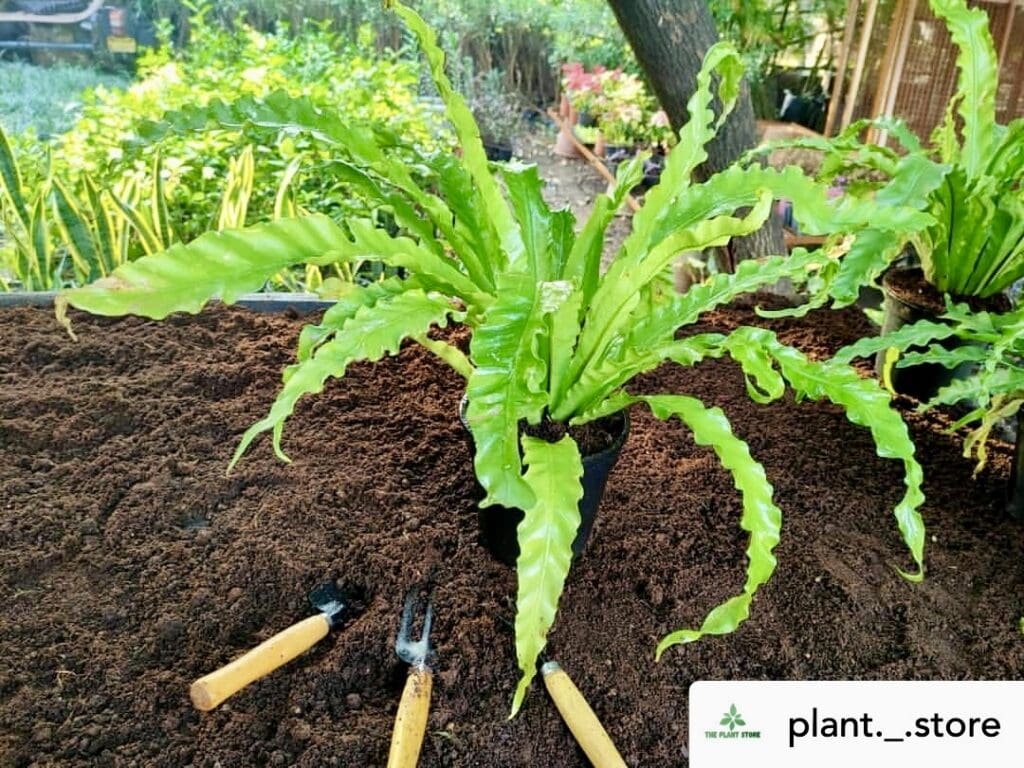
Are you ready to give your Bird’s Nest Fern a cozy new home? I’ve got the dirt on choosing the perfect pot and mastering repotting. Let’s dive in!
Choosing the Right Container
First things first, picking the right pot is crucial. Your fern will thank you for a home that’s snug but not too tight.
Always opt for a container that’s just an inch or two larger than the current one. A container with adequate drainage holes is a must to prevent waterlogging – soggy roots are a big no-no! 🚫💦
- Material: Terra-cotta or breathable plastic? Terra-cotta is great for moisture control, while plastic is lightweight and often more colorful.
- Size: An inch larger than the current root ball, but not too massive to avoid excess soil moisture.
Repotting Steps
Hey, don’t be nervous about repotting, okay? It’s like giving your fern a spa day! Here’s what I do:
- Gently take your fern out of its current pot. Sing a little tune to keep it calm… Maybe some plant-friendly jazz? 🌿🎶
- Shake off the old soil and check for rotten roots – snip if you find any.
- Place some fresh, peat-based potting mix in the new pot. Remember, these ferns love moisture but hate to swim!
- Center your fern in the new container, cover gently with more soil, and water it to settle in.
Pro-tip: Don’t bury the center of the fern! It needs to breathe, just like you and me. Give it a gentle pat, and voilà – your fern is all set!
Growth and Maintenance
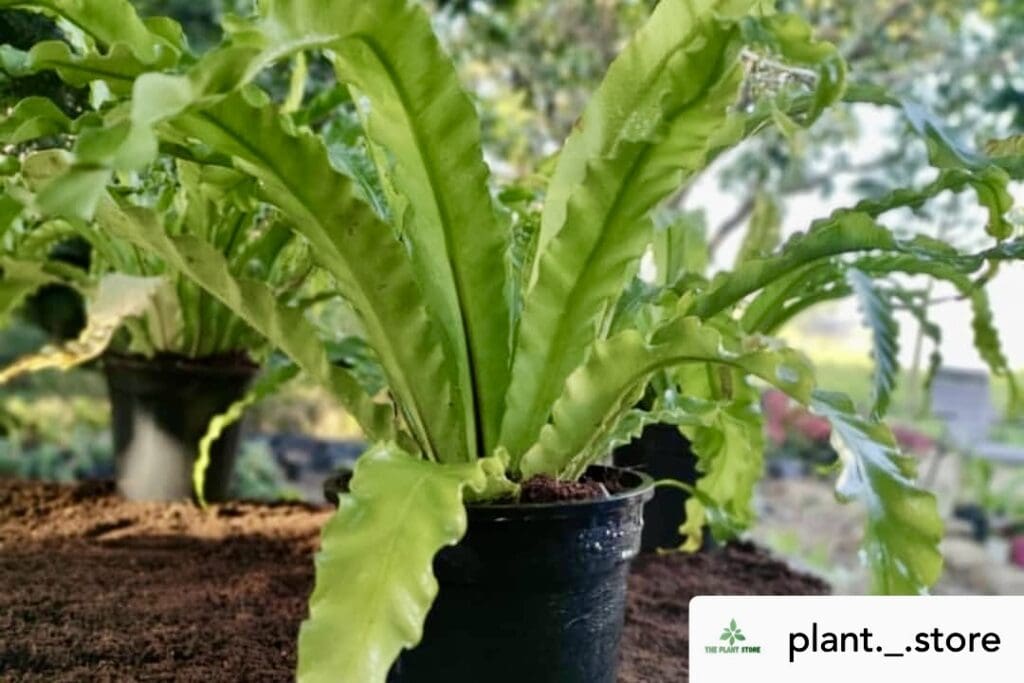
Taking care of a bird’s nest fern is easy-peasy with the right tips! Let’s dive into the nitty-gritty of fertilization and pruning, so our frond friends can thrive! 🌿
Fertilization Schedule
I always remember to give my bird’s nest fern a little nutrient boost during the spring and summer. Here’s how I do it:
- Frequency: Once a month
- Type: A balanced, liquid houseplant fertilizer
- Concentration: Diluted to half strength (Safety first, plant pals!)
- NPK ratio: Ideal is something like 20-20-20
Remember, overfeeding is a no-go. Too much of a good thing can be bad, right? 🍂
Pruning and Cleaning
Now, let’s talk about keeping those fronds fabulous! Pruning isn’t just for looks; it’s all about health, too.
- Remove dead or yellow leaves: Snip them off at the base to keep things tidy.
- Cleaning: Just a soft, damp cloth can make those leaves shine!
Extra tip: Be gentle. Bird’s nest ferns are more sensitive than my last-minute plans! 📅
Troubleshooting Common Issues
I know that seeing your bird’s nest fern thrive is super satisfying. But when issues pop up, don’t worry, I’ve got you covered. Here’s a quick guide to help you spot and resolve some of the most common hiccups!
Pest Problems
Have you been spotting some unwanted guests on your fern? Pests like red spider mites and scale insects can be a real party crasher for your plant. If you see fine webs or tiny shield-shaped bugs, it’s time to spring into action.
- Red Spider Mites: They’re tiny but mighty pests that love dry conditions.
- Fix: Wash your fern with a mild soapy water mix or reach for insecticidal soaps.
- Fix: Remember, these critters hate humidity, so a good misting now and then can keep them at bay!
- Scale Insects: Like mini turtles on your plant, these guys like to stick around.
- Fix: Introduce them to your friend, isopropyl alcohol. A dab on a cotton swab will make them disappear faster than my motivation on a Monday morning!
Disease Prevention
Ever had a plant that just seemed ‘off,’ like it caught a cold? 🤧 To prevent diseases, consistency is key.
- Root Rot: It’s like the plant version of athlete’s foot, and it’s a sneaky one.
- What To Do: Keep the soil evenly moist but not soggy – think a sponge that’s wet but not dripping.
- Leaf Spot: Brown or yellow patches popping up on the leaves? It could be a fungal issue.
- What To Do: Ensuring good air circulation and avoiding wet leaves during watering are your best defenses.
Leaf Discoloration
Ever put on mismatched socks? Well, leaves can look just as funky when something’s not quite right.
- Yellow Leaves: It might be screaming for a nutrient boost or signaling that it’s overly thirsty.
- Quick Tip: Check the watering schedule and make sure you’re not over or under-doing it.
- Brown Tips or Edges: This could mean the air is drier than my neighbor’s sense of humor.
- Fix: Boost that humidity! A pebble tray or a humidifier can turn your fern’s frown upside down.
Got any other tips or funny plant stories? Share yours in the comments! 🌿😊👇 Let’s learn from each other and keep our green buddies perky and prosperous!
Propagation Methods

Ever wonder how you can get more of those lush Bird’s Nest Ferns to spruce up your home? It’s all about perfecting two key techniques: Division and Spore Propagation. Ready to get your hands a little dirty and your home a lot greener? Let’s dive in!
Division Technique
I love when it’s time to play plant matchmaker! 🌿👩❤️👩 By dividing your healthy Bird’s Nest Fern, you’re essentially creating a new plant through cloning. Here’s the scoop:
- Gently remove your fern from its pot. It’s kind of like helping a friend move – be careful with their stuff!
- Inspect the root ball and look for a natural split in the rhizome. Think of it as finding the perfect slice point in a pie.
- Use a sharp knife (clean, of course!) to cut through the root mass. Aim for an even split, like sharing a cookie with your bestie.
- Repot each new division into its own container with a well-draining potting mix. You’ve just doubled your plant fun!
Remember to keep the soil moist and place your new ferns in indirect light. They’re not sunbathers, after all!
Spore Propagation
Feel like a science wizard with spores! 🧙💫 Spore propagation is a bit slower, but witnessing the magic makes it worth the wait.
- Find a mature frond with spores under its leaves. It’ll look like a tiny rusty polka-dot party!
- Collect the spores by cutting the frond and placing it in a paper bag. Give it a few days, and presto – spore confetti!
- Sprinkle the spores onto moist sphagnum moss or a similar medium. It’s time to sprinkle some plant magic!
- Moisture is key – these baby plants love the sauna life. Cover the container with plastic to keep the humidity high.
️Patience is your best friend here, as it can take several weeks to see the first signs of life. Talk about a suspenseful plant thriller!
Got your own propagation stories or tips? Drop them in the comments! I’d love to see your fern growing success stories or hear if these tips helped. If you give it a go, why not document your journey and tag a friend who’s got the green thumb vibes going on? Happy planting! 🌱👋
Decorative Tips for Display

If you’re like me and adore the lush, green vibes that Bird’s Nest Ferns bring to any space, then you’re in for a treat! I’ve got some snazzy ideas to showcase these beauties in your home.
On Shelves Who doesn’t love a good shelfie? Pop your fern on a high shelf and let those leaves do their elegant dance! 😍 Make sure the spot gets medium indirect light—no tanning for these delicate fronds!
Wall-mounted Planters Imagine this: Your ferns cascading down the wall like a green waterfall. Wall-mounted planters are not just space-savers but also real eye-catchers!
Terrarium-style Display Get creative and place your fern under a glass dome or in a large jar. It’s like a miniature rainforest that’ll make your guests go “Wow!”
Table Centerpieces A fern as the star of your dining table? Yes, please! Keep it in a chic pot that complements your decor. Just a little touch of nature to enhance those dinner parties. 🍽️
And remember, the key is to avoid direct sunlight to keep those leaves from playing the crispy game.
Got your own display tips or pictures of your fern setups? Drop a comment below and let’s exchange some green thumb high fives! 👋💚 Share this with your fern-loving buddies and let’s spread the leafy love! #BirdsNestFern #GreenYourSpace
Frequently Asked Questions

What’s the best way to water my Bird’s Nest fern?
I always recommend watering just enough to keep the soil consistently moist, but not soggy. Think of a sponge that’s nicely damp but not dripping wet! 😊
How often should I feed my green buddy?
During the spring and summer, a monthly treat of half-strength, balanced liquid fertilizer does wonders! Look for that magical NPK ratio of 20-20-20.
My fern’s leaves are looking crispy. What’s up with that?
Crispy leaves? It’s probably getting too much direct sunlight. These guys adore their medium indirect light or a spot with dappled sunshine. 🌤️
Is humidity important?
Absolutely! If you could give your fern a sauna, it would thank you. High humidity is where it’s happiest. 💦
Do I need a special soil mix?
Definitely. A mix of peat and perlite (think one part perlite to two parts peat) or a peat-based organic compost makes the perfect bed for your fern.
Conclusion
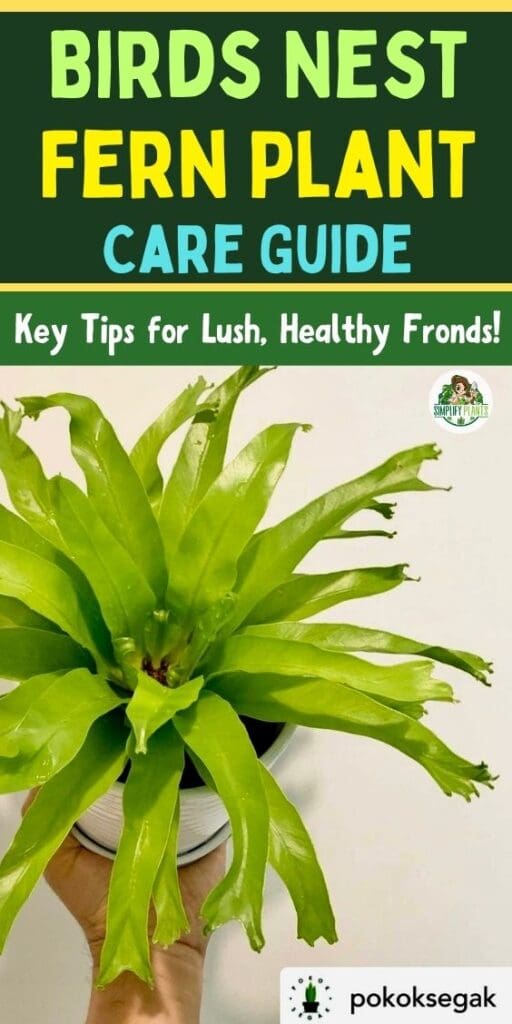
Bird’s nest ferns are amazing, aren’t they? 😍 While I cherish the lush, tropical vibe they bring to my home, I’ve found they are pretty easygoing with the right conditions.
Here’s a quick checklist to keep them happy:
- Bright, indirect light: An east or west window is their best friend.
- Warm temps: I aim for that sweet spot between 70-80°F. 🌡️
- Humidity lover: A bathroom or kitchen can be a spa retreat for them!
- Water wisdom: Moist but never soggy soil is the key to avoid those dreaded brown tips.
Now, who wouldn’t want a no-fuss tropical flair?
And when it comes to feeding, a gentle fertilizer during the growing season has worked wonders for me. Impressive fronds anyone? 🌿
But hey, enough from me. Have you tried placing them in different spots to find their happy place? Or maybe you’ve nailed the perfect watering schedule?
I’d love to hear about it! Drop a comment below and let the fern community know your top tips for these green beauties.
And don’t forget, if you’ve found this helpful or even had a little chuckle, share the fern love with a friend! 📤 Happy fern parenting! 🌱👩🌾
Recommended Garden Supplies
| Product Image | Our Recommended Gardening Supplies | Check Offers! |
|---|---|---|
Top Top
Top
Top
Top
Top
Top
Top
Top | rePotme Houseplant and Tropical Classic Potting Soil Mix | Check Offer On Amazon |
 Top
Top
Top
Top
Top
Top
Top
Top | Espoma Organic Indoor Plant Food | Check Offer On Amazon |
 Top
Top
Top
Top
Top
Top
Top
Top | GooingTop LED Grow Light 6000K Full Spectrum Clip Plant Growing Lamp | Check Offer On Amazon |
 Top
Top
Top
Top
Top
Top
Top
Top | Soil Moisture Meter | Check Offer On Amazon |
 Top
Top
Top
Top
Top
Top
Top
Top | Govee Hygrometer Thermometer, Bluetooth Enabled! | Check Offer On Amazon |
 Top
Top | LEVOIT Humidifiers for Large Room(Best For Plants) | Check Offer On Amazon |
 Top
Top
Top
Top
Top
Top
Top
Top | Upgraded DIY Automatic Drip Irrigation Kit, 15 Potted Houseplants Support | Check Offer On Amazon |
 Top
Top
Top
Top
Top
Top
Top
Top | Stainless Steel Heavy Duty Gardening Tool Set | Check Offer On Amazon |
 Top
Top
Top
Top
Top
Top
Top
Top | Bonide Insecticidal Soap | Check Offer On Amazon |
 Top
Top
Top
Top
Top
Top
Top
Top | Bonide 32 oz Spray Neem Oil for Organic Gardening | Check Offer On Amazon |
 Top
Top
Top
Top
Top
Top
Top
Top | Garden Safe Fungicide | Check Offer On Amazon |



